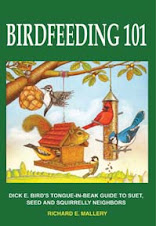• With no tools but a beak, birds construct nests that endure rain, wind and all other elements. They conserve heat well and hold restless young’uns.
• A ruby-throated hummingbird weighing in at less than one ounce can fly non-stop across the Gulf of Mexico.
• Birds have extremely bad breath. Scientists feel this is the reason most people feed them outdoors.
• The great horned owl is said to be one of the few animals that will eat a skunk. They will eat the whole thing, hook, line and stinker.
• A mockingbird has been known to change its tune 87 times in 7 minutes. For sheer variety, inventiveness, composition, and creation, no bird can equal the mocker. At five-thirty in the morning, they have many critics.
• Doves are the only birds that suck up water like a horse, instead of taking billfuls and letting it trickle down their throats.
• The fastest-running flying bird is the roadrunner. It has been clocked racing a car at 28 m.p.h. Its extended wings act as stabilizers.
• Some songbirds will eat until they double their weight, in preparation for their migration flight.
• Baby birds take their first breaths from the air stored in the blunt ends of the eggs.
• The sapsucker has a method all its own for collecting sap. It taps trees by drilling holes in the bark of the trunk in orderly rows that circle the trunk. it comes back often to drink at its wells and keeps the sap flowing.
• Nighthawks eat hundreds of insects per hour. They are sometimes called "mosquito hawks."
• An adult barn owl will eat approximately 23 to 25 mice per night, give or take a mouse.
• The great crested flycatcher and the tufted titmouse often use snakeskin in their nests—possibly for the mere purpose of adornment.
• The rule of estimating your costs on feeding birds and squirrels is to take your income—whatever that may be—and add 25 percent.
• Most birds suffer from ailurophobia. (Fear of cats.)
• Hummingbird wings are almost rigid and swivel at the shoulders.
• Long hind claws allow a nuthatch to hop down a tree trunk effortlessly.
• Woodpeckers are one of the few birds that will maintain a dwelling all year long.
• The cedar waxwing came by its name because if you look closely at the tips of some of the wing feathers, they resemble sealing wax. It is one of the finest tailored birds in the skies.
• California has more varieties of woodpeckers than any other state.
• It is believed that 60 percent or more of the small bird population is ordinarily replaced annually in what is called a "population turnover."
• Without exception birds come from eggs. (But where do eggs come from?)
• The bobolink gets so fat before it flys south for the winter, it is sometimes called the "butterbird."
• The hummingbird is a feathered prism, a living rainbow. Tiny barbs on each little plumule of each feather are so channeled as to break and refract the light, just as a cut diamond will do.
• A woodpecker can build a nesting site in a healthy hardwood tree. This job requires a beak equipped with an extremely hard sheath and a special type edge, with a chisel-shaped point.
• During the winter, the beautiful American goldfinch turns an olive green like the female but retains the white in the wings.
• Sparrows have short, conical bills which are ideal for their mixed diet of insects and grains. It also fits their faces really well.
• A woodpecker has a mean tongue from an insect’s point of view. It has a long reach and is equipped with a spiny tip, like a harpoon.
• The woodpecker’s toes, two forward, two back, help it climb tree trunks.
Mynah Offense—Lawyers say bird’s word wouldn’t hold up in a divorce court case.
A Chinese housewife sought a divorce claiming the family’s talking bird dropped clues on her husband’s ellicit affair. The woman said she uncovered the affair when their mynah bagan saying things such as "divorce," "I love you" and "Be patient" after it overheard the husband’s telephone calls with his mistress.
She hoped the bird could testify in court, but lawyers were not optimistic.
Thieving Birds—British scientists say thieving birds watch their backs more than honest birds do.
I don’t know how you tell a thieving bird from an honest bird—they all rip me off! But it seems jays that have previously taken food from others tend to move their own food to different locations to hide it from other sneaky predators like themselves.
The jays seem to have transferred their previous experience of being a pilferer to the current situation in which their own caches might be stolen. I’d watch the squirrels myself!




